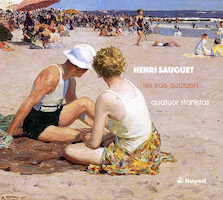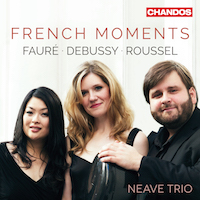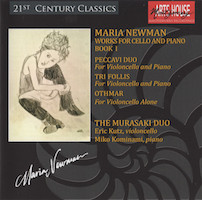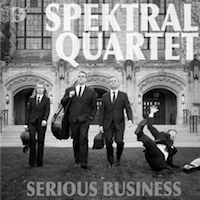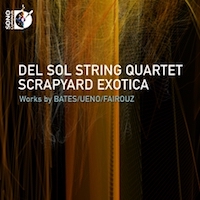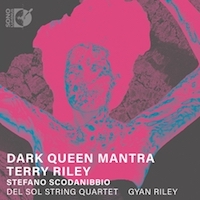String Theory 29.
|
Grant Chu Covell [December 2018.]
Henri SAUGUET: Quatuor No. 1 (1927; rev. 1941); Quatuor No. 2 (1947-48); Quatuor No. 3 (1979). Quatuor Stanislas: Laurent Causse, Bertrand Menut (vln), Marie Triplet (vla), Jean de Spengler (vlc). Timpani 1C1244 (1 CD) (http://www.timpani-records.com/). Sauguet’s Impressionism mellowed far beyond the World Wars. Written at 26, the confident yet casual First’s unabashed Romantic design aligns it with Brahms even though its lively gestures warrant compare with Ravel and Debussy. The initial theme bursts out with a straightforward upwards scale that yearns and charms. No. 2 is more personal, dedicated to the memory of the composer’s mother (Sauguet was his mother’s family name). Abrupt mood changes and straying chromaticism obscure flexible tonality. The Lento’s slowness is decidedly morose. Agility returns in the subsequent Valse, but this quartet’s mood is steadfastly gloomy. It would be easy to label the three-movement No. 3 as nonrepresentational, however; its refined motives are characteristic of its predecessors, elongated and somber, and dwelling upon dissonant turns. Another memorial, the Third is dedicated to Sauguet’s partner, Jacques Dupont. Sauguet knows where consonance lies, but earnestly dallies among ambiguity before resolving. Nos. 2 and 3 take more time to appreciate, but Quatuor Stanislas accomplishes all three with confidence and consistency so that the late stylistic change doesn’t baffle as much as it could. This quartet has made a specialty of unfamiliar 20th-century composers such as Jean Cartan, Louis Thirion, Joseph-Guy Ropartz and Othmar Schoeck.
“French Moments.” Albert ROUSSEL: Trio, Op. 2 (1902; rev. 1927). Claude DEBUSSY: Trio (1880). Gabriel FAURÉ: Trio, Op. 120 (1922-23). Neave Trio: Anna Williams (vln), Mikhail Veselov (vlc), Eri Nakamura (pno). Chandos CHAN 10996 (1 CD) (http://www.chandos.net/). The Neave Trio offers extraordinarily polished performances of one late (Fauré) and two early trios (Roussel, Debussy). Roussel’s grand effort finds comfort in liquid Germanic patterns. Happy to ramble and gush, it bears faint resemblance to Roussel’s mature clipped style which rebelled against Franck’s influence. The teen-aged Debussy’s Trio was written while functioning as house musician for Nadezhda von Meck (also Tchaikovsky’s patron) and bears little indication of the direction he would pursue beyond shunning German models, lingering just enough to show competence with its materials. Written at 77 years of age, Fauré’s mature Op. 120 is the true standout, warm and engaging from its passionate opening. We hear no indication that Fauré suffered from deafness and fatigue while writing this work. The central Andantino which immediately pairs violin and cello in lyrical operatic lines is nearly perfect and where the Neave glows. The Finale’s theme briefly incorporates Canino’s famous aria from Pagliacci, although in a context which suggests coincidence rather than something explicit.
Maria NEWMAN: Peccavi Duo (2009); Tri Follis (2010); Othmar (2000). The Murasaki Duo: Eric Kutz (vlc), Miko Kominami (pno). Arts House MAHMR 1205209 (1 CD) (http://www.malibufriendsofmusic.org/). Few instruments do dark and somber as well as the cello which Newman successfully exploits in the sonata, Peccavi Duo. In sharp contrast, Tri Follis explores witty and agile aspects of the cello-plus-piano combination. Both three-movement pieces employ a centered atonal language, agreeably distinct from modernist predecessors such as Shostakovich. Peccavi Duo is introspective where the shorter “Follies” are not, indeed we can imagine the pair acting out an unspecific scene and be surprised at its twists and turns. Othmar also asks for active listener participation during the tone poem based on characters by Mary de Morgan. The three movements for solo cello tell the story of Othmar and Hulda, the latter finding the former’s voice after it becomes lost. The Murasaki Duo plays with commitment and compassion.
“Serious Business.” Sky MACKLAY: Many Many Cadences (2014). David REMINICK: The Ancestral Mousetrap (2014). Franz Josef HAYDN: String Quartet in E-flat, Op. 33, No. 2, “The Joke” (1781). Chris FISHER-LOCHHEAD: Hack (2015). Spektral Quartet: Clara Lyon, Austin Wulliman (vln), Doyle Armbrust (vla), Russell Rolen (vlc). Sono Luminus DSL-92198 (1 CD, 1 Blu-ray) (http://www.sonoluminus.com/). Not all these pieces are funny per se although they do all involve humor. In order for wit to function in the musical realm, we must understand what is normal, and pick up on how the music thwarts expectations. It’s easy for a non-musician to get in on Haydn’s Joke: The Finale offers a false ending (or two). Even if the cadential ritual is not understood, a point is reached which feels like the end, and so it’s natural to applaud. But that’s the joke. The music pauses briefly and Haydn continues a bit more. It does help to understand what those V-I cadences are all about as Macklay’s 8:36 quartet creates chattering garlands from them. Cadences naturally move downwards, and Macklay exploits this waterfall effect which leads logically to wide leaps and soaring glissandos. I suspect the quartet finds it satisfying to slurp through proper voice leading. Speech figures in Reminick’s The Ancestral Mousetrap and Fisher-Lochhead’s Hack. The Ancestral Mousetrap has a text by Russell Edson to recite while playing, a five-part collection of morbid stories. Hack is a precise musical realization of 16 comedians (Lenny Bruce, Richard Pryor, et al.), capturing their inflection and rhythm, grouped in four parts or sets. There are no audible words. It is not possible to infer what the original jokes were, but the ensemble’s motion is clearly determined by something external. Knowing there’s language behind the dissonant spluttering invites close listening in a futile attempt to puzzle it out. At program’s end, there is one last joke, easy to catch if you’ve been paying attention. As the Haydn is more familiar, do we listen with a different standard than to the contemporary pieces? Spektral’s Haydn is playful, especially in the Scherzo but appropriately understated in the closing Presto. A particular difficulty of the new pieces is appropriately incorporating the non-musical aspects which Spektral handles nimbly. The Macklay and Fisher-Lochhead are remarkably absorbing.
“Scrapyard Exotica.” Mason BATES: Bagatelles for String Quartet and Electronica (2011). Ken UENO: Peradam (2011). Mohammed FAIROUZ: The Named Angels (2012). Del Sol String Quartet: Kate Stenberg, Rick Shinozaki (vln), Charlton Lee (vla), Kathryn Bates (vlc). Sono Luminus DSL-92193 (1 CD, 1 Blu-ray) (http://www.sonoluminus.com/). “Dark Queen Mantra.” Terry RILEY: Dark Queen Mantra (2015)*; The Wheel & Mythic Birds Waltz (1983). Stefano SCODANIBBIO: Mas Lugares (su Madrigali di Monteverdi) (2003). Gyan Riley (e-guit)*, Del Sol String Quartet: Benjamin Kreith, Rick Shinozaki (vln), Charlton Lee (vla), Kathyrn Bates (vlc). Sono Luminus DSL-92215 (1 CD) (http://www.sonoluminus.com/). It’s good to see string quartets stray from the traditional, and with this pair of releases the Del Sol String Quartet explores different avenues with mixed results. One need not always associate bagatelles with Beethoven, but Bates’s four pieces don’t even come close. Rhythms may be non-standard now and again, but one soon tires of the feeble string writing and the sampled “percussion” derived from quartet sounds. Inspired by a mythical stone, Ueno’s Peradam unfolds as a tone poem and asks players to vocalize amid gritty and agitated textures. Ueno performs as a throat-singer and having discovered that the Del Sol violist can achieve some of the same effects, he incorporated those vocal techniques into the piece. The Named Angels refer to the four found in the Christian, Jewish and Islamic traditions: Michael, Israfel, Gabriel and Azrael. Each movement is a portrait. Fairouz’ vocabulary zips back and forth between scales and melodies distinctly Middle Eastern incorporating repetitive riffs that Glass or Nyman would be proud of. The Del Sol does so much more work in the Ueno and Fairouz and the results are readily apparent. Riley and Scodanibbio had worked together (the releases Diamond Fiddle Language and Lazy Afternoon among the Crocodiles, et al.) and so the pairing is not as farfetched as it may seem initially. Riley is a prolific creator of string quartets (the notes indicate that his collaboration with the Kronos Quartet has resulted in 13). Dark Queen Mantra was written specifically for the Del Sol quartet to perform with Gyan Riley, an accomplished guitarist and the composer’s son. In three parts, the composer informally considers Spain from different angles: a memorable hotel, the paintings of Goya, and in the title movement, something akin to a romance which turns solemn. There is actually no waltz in the 16 minutes of The Wheel & Mythic Birds Waltz, a fantasy which wanders over and around ragas and assorted bits and pieces. Scodanibbio’s free channeling of Monteverdi opens onto a spirited Allegro whose modal touches are remarkably close to the energetic parts of Riley’s The Wheel & Mythic Birds Waltz. Harmonics and sul ponticello bathe the Monteverdi transcriptions in grainy light. I had trouble seeing my way through the Riley, but was very grateful for the shorter inscrutable Scodanibbio.
Bates, Debussy, Fairouz, Fauré, Fisher-Lochhead, Haydn, M Newman, Macklay, Reminick, Riley, Roussel, Sauguet, Scodanibbio, Ueno
[More Grant Chu Covell, String Theory]
[More
Bates, Debussy, Fairouz, Fauré, Fisher-Lochhead, Haydn, M Newman, Macklay, Reminick, Riley, Roussel, Sauguet, Scodanibbio, Ueno]
[Previous Article:
Gone Fishing]
[Next Article:
Concerto Concentrations 4.]
|
